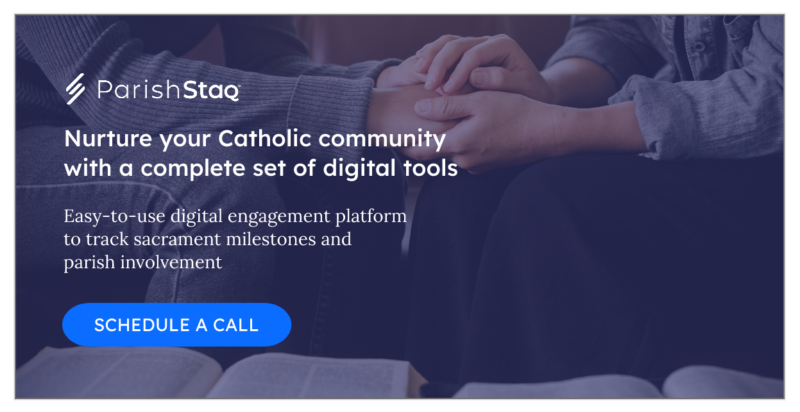
Church Capital Campaign Launch Preparation Guide
If your church is growing, you will need more than just fundraising. Learn more about a church capital campaign and how you can develop a successful one.
Even for a thriving parish, the day may come when tithes and offerings aren’t enough. You have goals and ambitions to build His Kingdom, but even with the generous support of your community, funding a significant expansion or a pressing need might feel out of reach.
This is where a capital campaign comes into play—but they’re no minor undertaking. A tremendous amount of planning, organization, and teamwork is required to start, and then you’re looking at years of effort to realize your vision.
But when your parish family reaches that peak together, all the hard work will be worth it.
What is a Church Capital Campaign?
Simply defined, a capital campaign is a long-term initiative to raise significant capital over and above a parish’s regular giving and tithes, all designated for a specific major project. You could run a campaign to fund new building construction or refurbishment, purchase land, fund an ambitious ministry, or even tackle your church’s existing debt.
But it’s so much more than typical church fundraising. A capital campaign will likely be one of the biggest events in the life of your parish, a time of great spiritual growth and connection within your community as your parishioners work together for years to conquer a huge undertaking that advances your shared mission.
The years your leadership and members spend working toward this goal will inevitably lead to challenges, but it’s truly a joyous time as you reach milestones together, marching toward a larger-than-life goal that will build His Kingdom.
Is a Church Capital Campaign Biblical?
Every church is united through the goal of spreading God’s lessons. A properly inspired, planned, and executed capital campaign will empower your church to extend its reach and accomplish this work on a larger scale.
As you consider initiating a capital campaign and brainstorm ideas, stay mindful of how this project will help you share God’s message more widely or more powerfully. Keeping Him front of mind is the first step toward running a successful church capital campaign.
How to Prepare for Your Church Capital Campaign
Know Why You’re Doing It
As a parish leader, you’ve probably already spent countless hours thinking through the myriad projects you’d love to accomplish. And, if you’re considering launching a capital campaign, you’ve likely already narrowed those ideas down to a few well-reasoned goals.
The key at this early stage is ensuring you can communicate that vision to your parishioners, fellow leaders, and the dozens of community members you’ll inevitably rely on throughout the project. To inspire participation and generosity, you’ll need to see this great work through, make sure you can clearly explain why this specific goal has been chosen and how it will advance the Church’s mission.
Understand Common Mistakes Made
The first step to avoiding the problems other churches have encountered in capital campaigns is to simply be aware of them. Leaders from other churches are a great resource; connect with anyone you know who’s spearheaded a campaign and have a frank discussion about the struggles they experienced. You can also find plenty of stories—both successful and cautionary—through online resources.
But to get you started, here’s a few all-to-common mistakes you should be aware of:
- Be realistic about timelines. Most capital campaigns run for one to three years—but you’ll need significant planning time even before that. Expect to spend months getting your team ready, doing research, calibrating your expectations, and so much more before you even consider launching the campaign.
- During this planning phase, think hard about all the people you’ll need to succeed. Yes, that includes members and leaders in your church, but will also likely include several outside experts as well. Who’s going to generate the marketing materials to raise funds? If you’re buying land or starting construction, which agents and contractors will you need to employ?
- Make sure you’re factoring in all the costs. As this is a long-term project, you’re sure to incur unexpected expenses that will hinder your financial goals. And don’t forget about inflation and market fluctuations: Your budget during the planning phase needs to account for potential shifting costs two or three years down the road. Learn how to manage church finances during a recession or any major disaster to prepare for these instances.
Build a Strong Leadership Team
According to Bloomerang, “Your capital campaign team is one of the most vital aspects that could determine the success of (or lack thereof) your campaign.” Establishing a broad, focused, and passionate group is the only way you’ll succeed.
You’ll want to pull from every level of your church. Leaders, of course, but the team shouldn’t be dominated solely by church leadership. Include staff members—especially your business manager, accountant, and stewardship coordinator, but also anyone else with a valuable perspective or skill set. And you should welcome several members of the congregation as well. Besides being your “boots on the ground” for raising enthusiasm and taking the temperature of membership, this will lend transparency and credibility to the project.
Complete a Feasibility Study
You’re going to need a lot of generosity—in time, talent, and treasure—to execute a successful church capital campaign. There’s no reason to spend months or years kickstarting a project if you don’t have realistic access to the resources you’ll need.
A feasibility study solves this problem. Essentially, through a series of candid and confidential interviews with staff and members, you discover your church’s ability and probability to financially support the project, willingness to volunteer their time, as well as their enthusiasm for the campaign and faith in the leadership team to deliver on their vision. This information is critical for establishing goals for the campaign.
Set Fundraising Goals
Armed with reliable insights from the feasibility study, you can now chart a course for fundraising.
Set benchmarks and timelines that you believe you can reach to give donors a sense of forward progress. Use previous giving data to understand the how and when of your congregation’s generosity, so you can plan major fundraising pushes at advantageous times of the year. You’ll also want to identify your major donors—this is exactly the type of large project they’d love to feel ownership over, so keep them included every step of the way. And of course, make sure you have a way to communicate with every member of your church, sharing inspiring progress updates or special requests outside of Sunday.
Plan Your Capital Campaign
It’s important to establish start and end dates. This campaign may take years, so couching it in hard deadlines gives your effort structure, as opposed to a nebulous project that may or may not come to fruition one day.
This is also the time to develop marketing materials. Printed case studies, infographics, concept imagery, project proposals, letterhead specific to the campaign and more are just a few of the ways your leadership team can show their commitment to the project, giving your church family further faith that you’re all working toward a common vision together.
Launch Your Campaign
Congratulations, it’s time to go live!
The number one rule during the campaign is transparency. You’re going to rely on many of the same donors repeatedly over the next few years—show them your progress, fast or slow, and break down exactly where their money is going. Someone may believe all their funds are going directly toward a land purchase, for example, when you’re actually hiring surveyors and developing more marketing materials. Don’t hide this reality. The quickest way to lose support is by seeming underhanded with the finances.
Prepare to send out appeals regularly, based on all the data you gathered during the planning phase, and with an emphasis on major donors. Again, these are the members you’ll surely rely on to hit your fundraising benchmarks, so regular communication and making them feel ownership is critical.
Evaluate Results
Constantly examining your progress during the campaign will help you identify what fundraising efforts are succeeding, and which aren’t delivering the results you expected. It’s more than just the raw dollar amount—look at how many parishioners are getting involved, how many are donating for the first time, which processes and tools they prefer to use when engaging and giving to your campaign, and more.
Breaking down information effectively is much more straightforward when your church takes advantage of a streamlined Catholic church management software like ParishStaq. Not only does our platform offer best-in-class analytics, but every solution we offer—communication tools, online giving, donor and event management, media hosting, custom mobile apps, and more—can all play an integral role in a successful capital campaign.
To see our latest tools in action, you can take a self-guided tour of our product offerings, or schedule a one-on-one demo with a Pushpay expert, and together we’ll explore how our technology can elevate your church’s mission.






